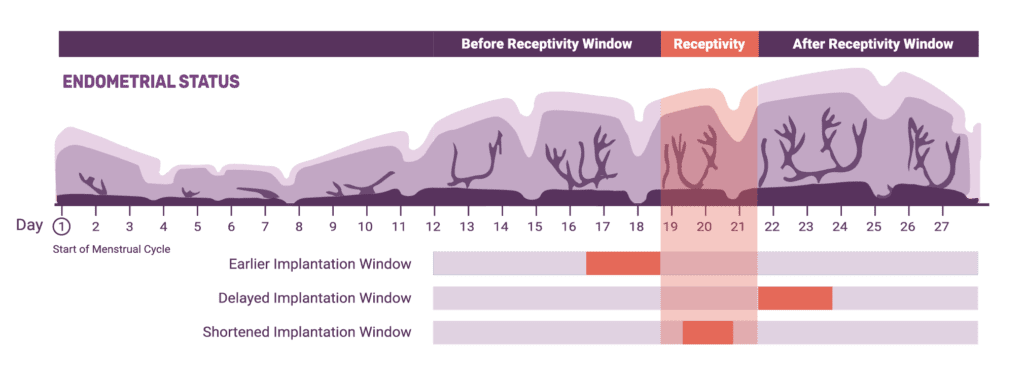microRNAs, Messenger RNAs, and their Diagnostic Value
microRNA (miRNA) and messenger RNA (mRNA) expression profiles both have diagnostic value, but each have their own functions in the body, making them distinctly important in science and medicine. Recalling our previous discussions on miRNAs, that miRNAs are 18-22nt long, non-coding, regulatory chunks of genetic material that inhibit or silence post-transcriptional activities, acting as master regulators of most of the body’s protein synthesis. The observation of the up- or down-regulation of specific groups of miRNAs in particular cells is proving key to diagnosing or predicting certain conditions. While other forms of genetic testing have become prevalent, miRNA-based analyses are swiftly garnering more attention as a prognostic and diagnostic tool in healthcare.
Endometrial Receptivity Testing
It is emerging that endometrial receptivity is one of the concerns for women who are dealing with infertility and have turned to assisted reproductive technology (ART) as a means of having children. In a paper from 2006, Makker and Singh define endometrial receptivity as “the period during which the endometrial epithelium acquires functional, but transient, ovarian steroid-dependent status supportive to blastocyst acceptance and implantation” (1).

mRNAs have traditionally been the most widely used genetic markers for identifying a variety of conditions. But getting results from biopsy samples is often difficult, as high-quality tissue samples can be difficult to obtain. This is also true in the case of endometrial receptivity testing. However, it has been demonstrated that miRNA profiles may be more accurate than mRNA profiles when it comes to disease classification (2).
Advantages of Using miRNA for Testing
miRNA offers several advantages as an indicator of endometrial receptivity. miRNA is more stable than mRNA meaning less tissue is required for analysis and results in a lower fail rate. Furthermore, the test developed at Inti Labs – MIRA™ – utilizes an algorithm that analyzes not just the target miRNAs, but other factors such as the patient’s age and BMI. As a result, the patients who may benefit the most from MIRA™ are those who meet any of the following conditions:
- Have experienced repeated implantation failure (RIF)
- Are age 35 or older
- Have few remaining viable embryos for IVF
- Have uterine abnormalities caused by infection, polyps, fibroids, and other conditions
- Have a BMI outside of the average range
Reliability
miRNAs are resistant to degradation as they are transported extracellularly within an exosome or, more commonly, as part of a Argonaute-protein complex. Arroyo et al. demonstrated in 2011 that miRNAs are more often associated with Argonaute2 (Ago2 – the same protein that complexes with miRNA to silence gene expression) and that it serves to protect the miRNA from RNases to which mRNA is vulnerable (3). They concluded that these two populations of circulating miRNA – vesicle bound, and Ago2 bound – are found in the plasma and that Ago2-bound miRNA allows for easy recovery and detection of miRNAs.

Another facet of reliability where miRNA has an advantage is a lower testing failure rate. Both providers and patients are discouraged by having to repeat tests due to inconclusive results, especially when that test is invasive and expensive. Where mRNA-based endometrial receptivity tests (ERTs) can have a failure rate higher than 5%, MIRA™ has a failure rate below 1% when it comes to pinpointing the patient’s window of implantation (WOI) (4,5).
Sensitivity
Consistency with testing is of critical importance; an assay needs to be repeatable for all patients. Ensuring enough tissue is collected during a biopsy, however, can be difficult. MIRA™ requires less material: 5-10mg of tissue from a biopsy compared to 30-50mg for mRNA-based ERTs (4).
Other mRNA-based tests analyze between 50-250 endometrial receptivity-related genes. MIRA™’s profile consists of 100 novel miRNAs that target over 600 ER-related genes, specifically miR-429, miR-125b, and miR-451, which target genes related to the establishment of the WOI (4,5,6).
Accuracy
miRNA profiles often have higher success rates at determining disease conditions (2,7) and can be more accurate than measuring mRNA profiles or protein output. MIRA™ has a 90% success rate at predicting a displaced window of implantation as cause for implantation failure(4). This is an important factor to consider during IVF treatment, especially for patients suffering from RIF.
Recent Independent Evaluation of ERTs
A recent study published in Human Reproduction concluded that using mRNA-based ERTs may not accurately predict the WOI (8). The authors’ analysis illustrates there may be little to no benefit of an mRNA-based ERT at all. However, one factor missing from this re-analysis is that the benefit of ERT may be greater for RIF patients. Bearing this in mind, this report may be the conclusive next step that pushes researchers and clinicians to look for better forms of analysis, such as miRNA-based testing, and better pinpointing the patient groups that would benefit from ERTs.
Inti Labs’ Solutions
Clinical data has shown that MIRA™’s algorithm can accurately predict patients’ WOI, allowing for more-perfectly timed blastocyst transfers. It requires less biopsy material and delivers more accurate results. Furthermore, the presence of circulating miRNAs in plasma means that this technology has the potential to become non-invasive. Inti Labs has recently capitalized on this advantage to develop ora™, the world’s first non-invasive endometrial receptivity test.
ora™: Non-Invasive Endometrial Receptivity Test
ora™ is the first and only non-invasive endometrial receptivity test, able to accurately identify the WOI of patients using blood samples. ora™’s non-invasive nature drastically improves the patient experience, and potentially eliminates the need for mock cycles if blood is drawn from patients alongside their first embryo transfer cycle.
More research and clinical validation is needed to understand the full scope of ora™’s benefits, but early results are promising. We’ll be sharing more about ora™ and its path to clinical validation soon, so stay tuned!
References
1 Makker A, Singh MM. Endometrial receptivity: clinical assessment in relation to fertility, infertility, and antifertility. Med Res Rev. 2006 Nov;26(6):699-746. doi: 10.1002/med.20061. PMID: 16710862.
2 Lu J, Getz G, Miska EA, Alvarez-Saavedra E, Lamb J, Peck D, Sweet-Cordero A, Ebert BL, Mak RH, Ferrando AA, et al: MicroRNA expression profiles classify human cancers. Nature. 2005, 5: R13-
3 Arroyo JD, Chevillet JR, Kroh EM, Ruf IK, Pritchard CC, Gibson DF, Mitchell PS, Bennett CF, Pogosova-Agadjanyan EL, Stirewalt DL, Tait JF, Tewari M. Argonaute2 complexes carry a population of circulating microRNAs independent of vesicles in human plasma. Proc Natl Acad Sci U S A. 2011 Mar 22;108(12):5003-8. doi: 10.1073/pnas.1019055108. Epub 2011 Mar 7. PMID: 21383194; PMCID: PMC3064324.
4 Chen CH, Lu F, Yang WJ, Yang PE, Chen WM, Kang ST, Huang YS, Kao YC, Feng CT, Chang PC, Wang T, Hsieh CA, Lin YC, Jen Huang JY, Wang LH. A novel platform for discovery of differentially expressed microRNAs in patients with repeated implantation failure. Fertil Steril. 2021 Apr 3:S0015-0282(21)00088-1. doi:10.1016/j.fertnstert.2021.01.055. Epub ahead of print. PMID: 33823989.
5 Altmäe, S., Martinez-Conejero, J. A., Esteban, F. J., Ruiz-Alonso, M., Stavreus-Evers,
A., Horcajadas, J. A., & Salumets, A. (2012). MicroRNAs miR-30b, miR-30d, and miR-494
Regulate Human Endometrial Receptivity. Reproductive Sciences, 20(3), 308-317.
doi:10.1177/1933719112453507
6 Reza, A. M., Choi, Y., Han, S. G., Song, H., Park, C., Hong, K., & Kim, J. (2018). Roles of microRNAs in mammalian reproduction: From the commitment of germ cells to peri-implantation embryos. Biological Reviews, 94(2), 415-438. doi:10.1111/brv.12459
7 Umu SU, Langseth H, Bucher-Johannessen C, Fromm B, Keller A, Meese E, Lauritzen M, Leithaug M, Lyle R, Rounge TB. A comprehensive profile of circulating RNAs in human serum. RNA Biol. 2018 Feb 1;15(2):242-250. doi: 10.1080/15476286.2017.1403003. Epub 2017 Dec 8. PMID: 29219730; PMCID: PMC5798962.
8 Richter, Kevin S., Richter, Martin L., Personalized embryo transfer reduces success rates because endometrial receptivity analysis fails to accurately identify the window of implantation, Human Reproduction, 2023;, dead083, https://doi.org/10.1093/humrep/dead083



